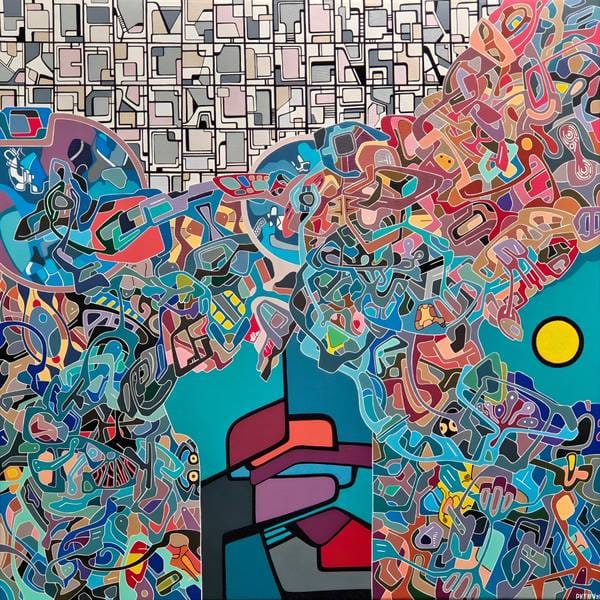Beyond Geometry: Famous Shape Art and How to Style It in Your Home
Let’s be honest for a second. The world is loud. Your phone is buzzing, the news is chaotic, and your schedule is packed. Is it any wonder that when we come home, we’re desperate for something that just makes sense?
That is the secret power of geometry. It’s not just math on a canvas; it’s a visual deep breath.
For over a century, artists have obsessed over this. They realized that while a portrait tells a specific story, a circle or a square speaks a universal language. It hits your subconscious before you even realize it. When we talk about famous shape art, we aren’t just discussing art history textbooks—we are talking about the pioneers who figured out how to calm (or excite) the human brain using nothing but form and color.
The Rebels: Famous Shape Artists Who Dared to Simplify
It’s easy to look at a grid or a triangle today and think, "I could do that." But try to imagine doing it a hundred years ago, when everyone else was obsessed with painting realistic fruit bowls. These famous shape artists were the punks of their generation. They broke the rules so we could enjoy the peace.
Piet Mondrian: The Obsessive Pursuit of Balance
I have always fascinatingly viewed Mondrian not just as a painter, but as a philosopher of balance. He stripped everything down to the absolute basics: horizontal lines, vertical lines, and primary colors. That’s it. His famous paintings with shapes (specifically rectangles) aren't empty; they are full of tension held in perfect check. Hanging a Mondrian-style piece is like telling your room: "Everything is under control."
Wassily Kandinsky: Can You Hear the Painting?
Kandinsky was different. While Mondrian was rigid, Kandinsky was an explosion. He reportedly had synesthesia—he could essentially "hear" colors. So, when you look at his famous artwork with shapes, you aren't just seeing circles and triangles; you’re looking at visual music. His work reminds me that geometry doesn't have to be cold. It can be loud, messy, and beautifully emotional.
Kazimir Malevich: The Mic Drop
And then there’s Malevich. In 1915, he painted a black square on a white background. It was radical. It was aggressive. It was the "mic drop" of art history. By creating arguably the most famous art with shapes ever made (The Black Square), he forced the viewer to stop looking for a "picture" of something and just feel the weight of the form itself. It’s bold, and frankly, it takes confidence to pull off.
From History Books to Your Living Room
Okay, let’s pivot to reality. Unless you have an extra $50 million gathering dust, you probably won't be bidding on an original Malevich at Sotheby's. But here is the thing: you don’t need the original to channel that energy.
In modern interior design, "shape art" is the ultimate hack. It’s how you make a space look expensive and curated without trying too hard. We live in cluttered times; we don't need more visual noise on our walls. We need anchors. We need art that brings order to the chaos.
The Subjektiv Approach
This is exactly why we created subjektiv.art.
We got tired of generic posters that felt soulless. We wanted to recapture that revolutionary spirit of the early 20th century but with a fresh, contemporary pulse. Our artists aren't just drawing shapes; they are playing with the same principles of weight, balance, and color theory that the masters did.
Check out Geometric Art & Sculpture selection by Subjektiv.

Whether you crave the soothing logic of a grid or the dynamic energy of intersecting arcs, our collection is designed for the modern home—not a museum archive.
How to Actually Style This Stuff
I get asked about placement all the time. Here is my unfiltered advice on styling:
- Don't Match, Echo: Please, don't try to perfectly match the art to your sofa. It looks like a hotel catalog. Instead, look for a "color echo." If the art has a tiny sliver of burnt orange, maybe have a burnt orange vase across the room. It’s subtle. It’s cool.
- Soft vs. Sharp: If your apartment is full of IKEA squares and sharp edges, don't add more squares. Buy a piece with circles or arches. You need to break the rigidity, not reinforce it.
- Give It Air: Famous paintings with shapes work because of the empty space around them. Do the same. Don't crowd a geometric print on a busy gallery wall. Give it its own wall. Let it breathe.
Final Thoughts
Shapes are primal. They are simple. And in a complicated world, simplicity is the ultimate luxury.
If you are ready to bring some sophisticated order to your walls, come take a look at what we’re doing. Browse our exclusive collection of shape-inspired art at Subjektiv.art. Trust me, your walls will thank you.



